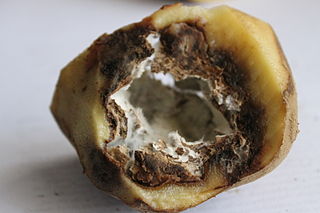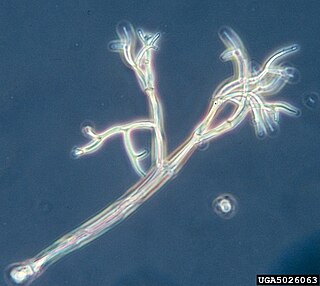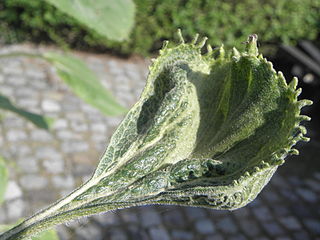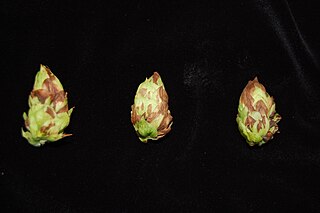
Downy mildew refers to any of several types of oomycete microbes that are obligate parasites of plants. Downy mildews exclusively belong to the Peronosporaceae family. In commercial agriculture, they are a particular problem for growers of crucifers, grapes and vegetables that grow on vines. The prime example is Peronospora farinosa featured in NCBI-Taxonomy and HYP3. This pathogen does not produce survival structures in the northern states of the United States, and overwinters as live mildew colonies in Gulf Coast states. It progresses northward with cucurbit production each spring. Yield loss associated with downy mildew is most likely related to soft rots that occur after plant canopies collapse and sunburn occurs on fruit. Cucurbit downy mildew only affects leaves of cucurbit plants.

Peronosporaceae are a family of water moulds that contains 21 genera, comprising more than 600 species. Most of them are called downy mildews.

Albugo candida, commonly known as white rust, is a species of oomycete in the family Albuginaceae. It is sometimes called a fungus, but in fact forms part of a distinct lineage of fungus-like microorganisms, Oomycetes, commonly known as water moulds. A. candida is an obligate plant pathogen that infects Brassicaceae species and causes the disease known as white rust or white blister rust. It has a relatively smaller genome than other oomycetes.

Hyaloperonospora brassicae, in the family Peronosporaceae, is a plant pathogen. It causes downy mildew of species of Brassica, Raphanus, Sinapis and probably other genera within the Brassicaceae. In the past, the cause of downy mildew in any plant in the family Brassicaceae was considered to be a single species Peronospora parasitica. However, this has recently been shown to be a complex of species with narrower host ranges, now classified in the genus Hyaloperonospora, for example Hyaloperonospora parasitica on the weed Capsella bursa-pastoris. From the perspective of plant pathology, Hyaloperonospora brassicae is now the name of the most important pathogen in this complex, attacking the major agricultural and horticultural Brassica species. Other significant Brassicaceous hosts are attacked by different species in the complex, e.g. horseradish by Hyaloperonospora cochleariae, wallflower by Hyaloperonospora cheiranthi.

Hyaloperonospora is a genus of oomycete, obligate, plant pathogens that was originally considered to be part of Peronospora. Species in this group produce a disease called downy mildew and can infect many important crops. From the 19 downy mildew producing genera, Hyaloperonospora has been grouped with Perofascia in the brassicolous downy mildews. In the group of downy mildews, Hyaloperonospora is the third biggest genus. The most famous species in the genus is the Hyaloperonospora parasitica, or also known as Hyaloperonospora arabidopsis. This species has become a model organism from its ability to infect the model plant Arabidopsis thaliana. It is used to study plant-pathogen interactions, and is currently the only Hyaloperonospora species that has an assembled genome.

Peronospora sparsa is an oomycete plant pathogen that causes downy mildew in berry producing plants; especially in the genus's Rubus and Rosa. Downy mildew plant pathogens are often host specific and cause problems in cloudberries, blackberries, boysenberries, strawberries, and arctic bramble. Since they are host specific, Peronospora sparsa will not cause downy mildew in grapes because a different plant pathogen causes downy mildew in grapes; Plasmopara viticola. Although it depends on the cultivar, symptoms do not normally start until later stages of disease and can look different on different plants. The most common symptoms include red lesions in the veins of leaves, with dry and deformed berries.

Bremia lactucae is a plant pathogen. This microorganism causes a disease of lettuce denominated as downy mildew. Some other strains can be found on 36 genera of Asteraceae including Senecio and Sonchus. Experiments using sporangia from hosts do not infect lettuce and it is concluded that the fungus exists as a quantity of host-specific strains. Wild species, such as Lactuca serriola, or varieties of Lactuca can hold strains that infect lettuce, but these pathogens are not sufficiently common to seriously infect the plant.
Peronospora conglomerata is a biotrophic plant pathogen which affects geranium species. Its conidiophores are tree-like and come from the stomata on the leaves. The conidiophores cover the underside of the affected plant's leaves in white patches. These patches may later turn purple or brown. The result of infection by Peronospora conglomerata is scrunched up, yellow leaves that are reduced in size and are prone to falling off.

Peronospora farinosa is a species name that has been widely applied to downy mildew on leaves of wild and cultivated Amaranthaceae: Amaranthus, Atriplex, Bassia, Beta, Chenopodium, Halimione, Salsola, Spinacia, etc. However, the species name has been taxonomically rejected as the original description contained reference to multiple species and could not unequivocally be attributed to a species of Peronospora. In the past, some of the species on important crop plants have been given names as formae speciales, notably f.sp. betae on sugar beet and f.sp. spinaciae on spinach. However, phylogentic reconstructions have revealed that these "forms" of Peronospora on different genera and their subdivisions, are distinct species, most of which already have previously published scientific names. Such host specialization possibly also exists with respect to the various wild amaranthaceous species given as hosts of P. farinosa.

Peronospora manshurica is a plant pathogen. It is a widespread disease on the leaves of soybeans and other crop plants. The fungi is commonly referred to as downy mildew, "leafspot", or "leaf-spot".

Plasmopara halstedii is a plant pathogen infecting sunflowers. The species is one of many pathogens commonly referred to as downy mildew. P. halstedii originated in North America.

Plasmopara viticola, the causal agent of grapevine downy mildew, is a heterothallic oomycete that overwinters as oospores in leaf litter and soil. In the spring, oospores germinate to produce macrosporangia, which under wet condition release zoospores. Zoospores are splashed by rain into the canopy, where they swim to and infect through stomata. After 7–10 days, yellow lesions appear on foliage. During favorable weather, the lesions sporulate and new secondary infections occur.

Pseudoperonospora humuli is a plant pathogen that causes downy mildew on hops.
Peronosclerospora sorghi is a plant pathogen. It is the causal agent of sorghum downy mildew. The pathogen is a fungal-like protist in the oomycota, or water mold, class. Peronosclerospora sorghi infects susceptible plants though sexual oospores, which survive in the soil, and asexual sporangia which are disseminated by wind. Symptoms of sorghum downy mildew include chlorosis, shredding of leaves, and death. Peronosclerospora sorghi infects maize and sorghum around the world, but causes the most severe yield reductions in Africa. The disease is controlled mainly through genetic resistance, chemical control, crop rotation, and strategic timing of planting.

Peronospora is a genus of oomycetes that are obligate plant pathogens of many eudicots. Most species in this group produce a downy mildew disease, which can cause severe damage to many different cultivated crops, as well as wild and ornamental plants. There are 19 genera that produce downy mildew, and Peronospora has been placed alongside Pseudoperonospora in the group of downy mildews with coloured conidia. Peronospora has far more species than any other genus of the downy mildews. However, many species have been moved from this genus to be reclassified to other or new genera. Among these was the most famous Peronospora species, formerly known as Peronospora parasitica, and now known as Hyaloperonospora parasitica. Now, the Peronospora species of most importance is likely the Peronospora tabacina. Peronospora tabacina causes blue mold on tobacco plants and can severely reduce yields of this economically important crop to the point where it has been classified as a bioweapon.

Peronospora hyoscyami f.sp. tabacina is a plant pathogen infecting tobacco that causes blue mold. It is an oomycete that is highly destructive toward seed plants. It is very prevalent in humid farming zones, like the southeastern and eastern U.S., Canada, and countries bordering the Caribbean. The disease was first identified in 1921 in Florida and Georgia. Ten years later the same disease was found once again in the same region of the U.S. The disease began to spread into Virginia, Maryland, and North Carolina. A few years later, the disease reached Kentucky and Tennessee. In 1960, a blue mold epidemic spread in approximately eleven countries. There was approximately twenty five million dollars in losses which is nearly thirty percent of tobacco plants at the time. Each year, Peronospora hyoscyami is introduced as blue mold as windblown spores from outside the region by infected transplants.

Hyaloperonospora arabidopsidis is a species from the family Peronosporaceae. It is an obligate parasite and the causal agent of the downy mildew of the plant model organism Arabidopsis thaliana. While H. arabidopsidis has for a long time been subsumed under Peronospora parasitica, recent studies have shown that H. parasitica is restricted to Capsella bursa-pastoris as a host plant. Like the other Hyaloperonospora species, H. arabidopsidis is highly specialized to Arabidopsis thaliana.

Peronospora destructor is a plant pathogen. It causes downy mildew on leaves of cultivated and wild Allium. Allium cepa is most often affected, while Allium schoenoprasum (chives) and Allium porrum (leek) are only occasionally affected.
Commonly known as Philippine downy mildew, this disease is caused by the species Peronosclerospora philippinensis of the fungal-like protist class Oomycetes, which also has members such as water molds and Phytophthora infestans, which caused the potato blight that led to the Great Irish famine.
Peronospora aquilegiicola is a species of oomycete in the family Peronosporaceae, first described in 2019. It is a plant pathogen: it can infect susceptible plants belonging to the genus Aquilegia, causing the plant disease Aquilegia downy mildew, as well as plants belonging to the genus Semiaquilegia. Peronospora aquilegiicola is native to East Asia, however it has a widespread distribution in the United Kingdom, and has since been detected in the German states of Lower Saxony, North Rhine-Westphalia, and Bavaria.















